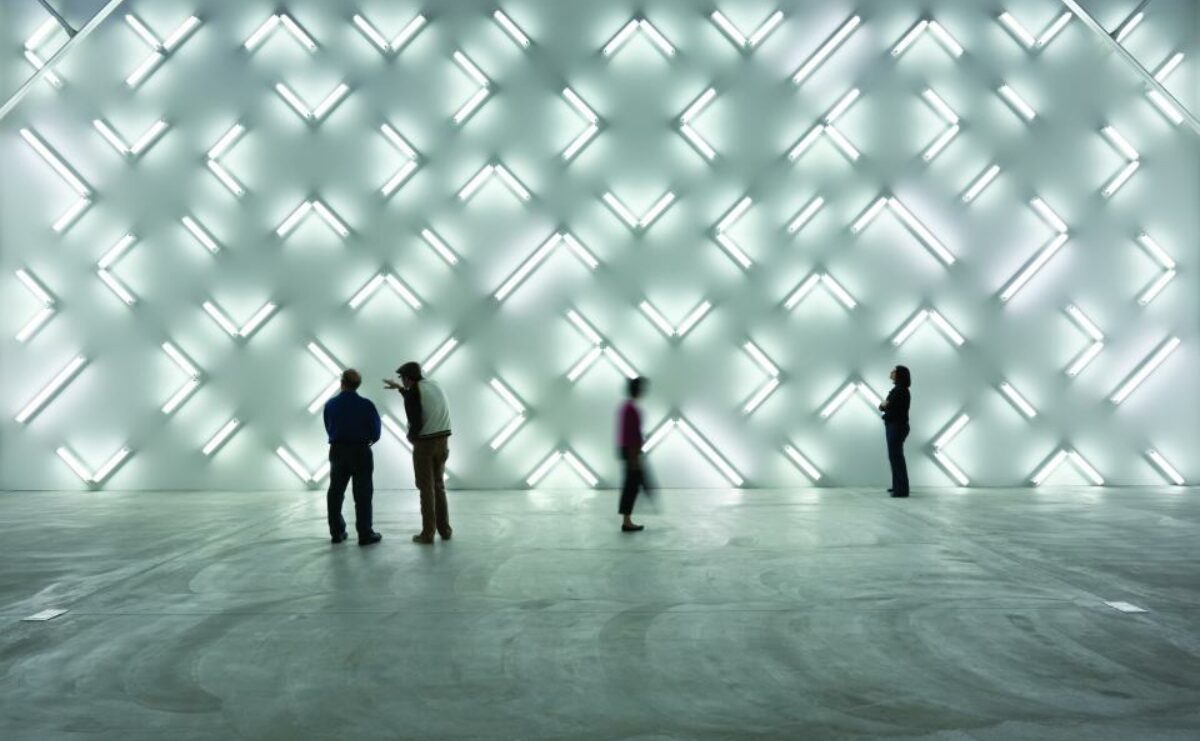We’re closed today but visit us soon!

October 21, 2007 to February 23, 2008
Formerly On view at MCASD Downtown
The largest exhibition of Irwin’s work since 1993, Robert Irwin: Primaries and Secondaries featured five new major installation works created specifically for the Museum of Contemporary Art San Diego’s downtown galleries, and was drawn almost exclusively of works from the Museum’s collection. The exhibition, a survey spanning more than 50 years of work, was curated by Hugh M. Davies, then David C. Copley Director at MCASD, and was on view at both the Joan and Irwin Jacobs Building and the former 1001 Kettner galleries.
Of the five new major site-determined installations, four will premiere at MCASD, and a fifth, Who’s Afraid of Red, Yellow & Blue , is a larger version of the three-room piece that appeared at PaceWildenstein, New York in December 2006. The two enamel paint on honeycomb aluminum works, and the fluorescent installation are new departures for the artist.
While specific objects are utilized in these installations, they serve as a passive platform to facilitate the transformation of energy and to trigger a phenomenal, visual experience. The enameled panels of Who’s Afraid of Red, Yellow & Blue (2007) and Primaries and Secondaries (2007) function as colored mirrors whose complex reflections enable us to see the world in a new light while at the same time spark interlaced art historical connotations, from color theory to mid-20th century Modernist Abstraction.
Light itself focuses and diffuses our gaze in Irwin’s environmental light installation Light and Space (2007), consisting of two-foot and four-foot colorless fluorescent tubes mounted on the north wall of the Foster Gallery in the Jacobs Building. The piece creates a dialogue between solid architecture and empty space mediated by electric light–three forms of matter at different accelerations. In this work–developed during Irwin’s residency in MCASD’s Robert Caplan Artist-in-Residence Studio–he uses for the first time fluorescent light tubes alone as the main triggers of a mass-less, enveloping perceptual experience.
In another work, Square the Room (2007), Tergal voile fabric, a type of scrim material, functions to redefine the contour of the Royston Gallery at 1001 Kettner–to literally “square” its sharply obtuse-angled walls. Finally, in Five x Five (2007), created in response to the interior volume of the Copley Gallery at 1001 Kettner, five black scrim and five white scrim panels are placed perpendicularly to create a subtly changing monochrome mass out of the empty space between walls and ceiling.
The location of Southern California is primary to Irwin’s work, and the vast, light-filled spaces at MCASD’s Jacobs Building and the Irwin-designed high-ceiling spaces with abundant windows and skylight of 1001 Kettner are both particularly well-suited to show the work to its best advantage. Together with artist Richard Fleischner and architect David Raphael Singer, Irwin designed the museum spaces at 1001 Kettner, which opened in 1993.
MCASD has collected the artist’s groundbreaking work in depth, and this exhibition included a wide range of work–from early Abstract Expressionist paintings to minimal canvases, and from early sculptural objects, including his seminal disks and acrylic columns, to large installations. MCASD has an ongoing commitment to collecting and preserving the work of this American master and has over 50 works by Irwin in the Museum’s collection.
The exhibition was accompanied by a catalogue that includes a scholarly essay written by Davies; 30 full-spread color images documenting the exhibition and new installations; a transcript of an interview between Irwin and Davies; and five previously-published essays selected from Irwin’s distinguished theoretical output to give further context to the extraordinary artistic contribution of this eminent West Coast artist. A video documentary of the installation process was included with the catalogue and provides rare insight into Irwin’s on-site approach.